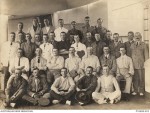GAYNOR, Edward John
Edward John Gaynor was the son of Police Constable Edward James Gaynor and his wife Margaret Anne, nee Edwards, known as Annie. The family lived at 'Wendouree', 56 Albert St., East Melbourne. There were two girls in addition to Edward, Eileen and Marie. On 1 May 1915, when he enlisted, Ted just under 26 years old and was set on a promising career: he had passed the Junior Public Exam at Melbourne University, the Commonwealth Public Service Clerical Exam and was working as a Federal Civil Servant in the Prime Minister's Department. It was a time when Parliament was situated in Melbourne, so living in East Melbourne gave him easy access to work. In addition, he had already spent four and a half years in army training, and was a commissioned Lieutenant, having been commissioned as Second Lieutenant on 27 February, 1912.
He was placed with the 23rd Battalion of the AIF and set sail on HMAT Euripedes for Egypt on 8 May, 1915. They joined the Middle East Force on, then on 30 August, 1915, proceeded to join the ANZACs at Gallipoli. Three months later, on 24 November, he was hit by a bomb blast, which shattered his right forearm and fractured the ulna. It was the end of his promising military career. he was taken to the 6th Field Ambulance, then transferred to the Hospital Ship Glenart, then shipped to the 3rd Auxiliary Hospital at Malta, where he was admitted on 9 December, 1915. On 15 March, 1916, he was placed on the Supernumerary List, an admission that he was no longer capable of military service.
He was not fully recovered when he was sent back to Egypt on the Essquibo on 25 March, en route for Australia. He was off-loaded at Alexandria and admitted to hospital at Heliopolis. From Heliopolis, he continued his journey home, boarding HT Karoola on 12 April, 1916. In his absence, the Medical Board held a hearing at the No. 3 Auxiliary Hospital in Malta, and conluded that he was suffering from paresis of the right arm, the result of a compound fracture and loss of the 3rd right ulna bone caused by the bomb wound received at the Gallipoli Peninsula on 24 Novemer, 1915. He was declared unfit for any further military service and returned to Australia, where he was discharged at Melbourne on 13 January, 1917.
Edward Gaynor was for some time in the Australian General Hospital at Caulfield and was given a pension of 80/- per fortnight in recognition of his injury. This was later reduced to 40/-. then to 26/6d, presumably as he recovered. Once recovered, he joined the 3rd District Guard of the home service unit. It was while travelling in an army car, that he was injured again, this time in a collision with a cable tram in St. Kilda, outside Victoria Army Barracks, and received head and eye injuries.
In the 1922 Electoral Roll, he was living with his parents at 56 Albert St, East Melbourne, where they remained until at least 1922. By then, he was back working as a Federal Civil Servant. In 1925, the family was living at 479 Church St. Richmond. He married his wife, Mary, and by 1931, they were living at 17 Lyall St., Hawthorn, where they stayed for the whole of their married lives and brought up four children, John Edward, Mary Margaret, Anne Elizabeth and Anthony Joseph.
Museum Victoria has Edward Gaynor's army uniform and tropical service helmet in their collection. The Australian War Museum has black and white photocopies of eight letters he wrote to his nephew Bernard from Gallipoli in 1915. IDnumber PA83/163
Australian War Memorial, Embarkation Record
Australian National Archives, Service Record
Ancestry.com.au, Elecroral Roll, Birth Death and Marriage Indices, Public Member Trees
Hobart Mercury, 20 Dec 1915, p6, mention of wounding

